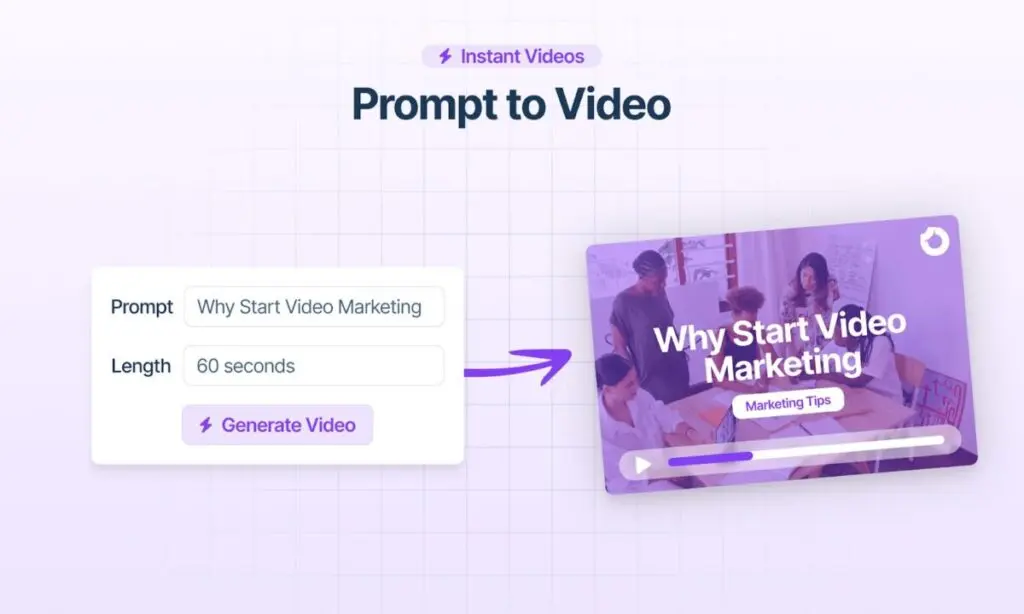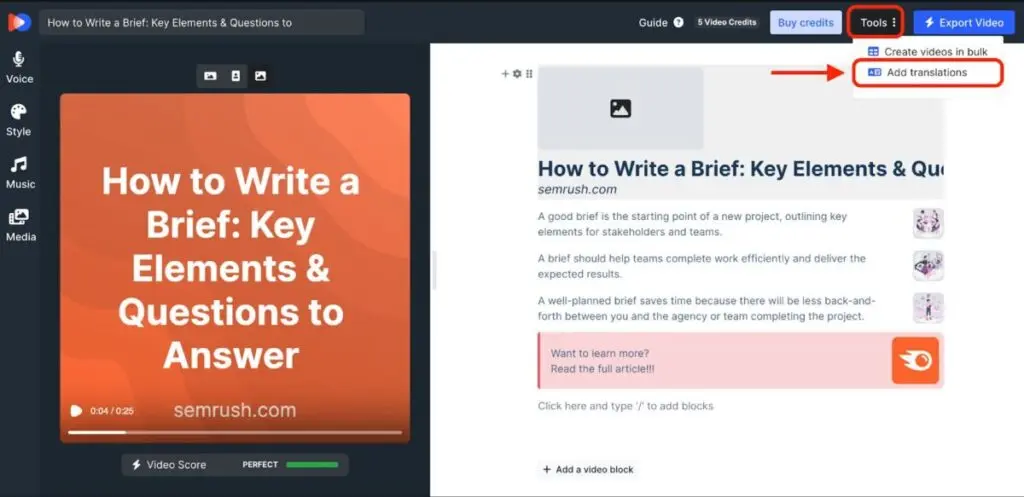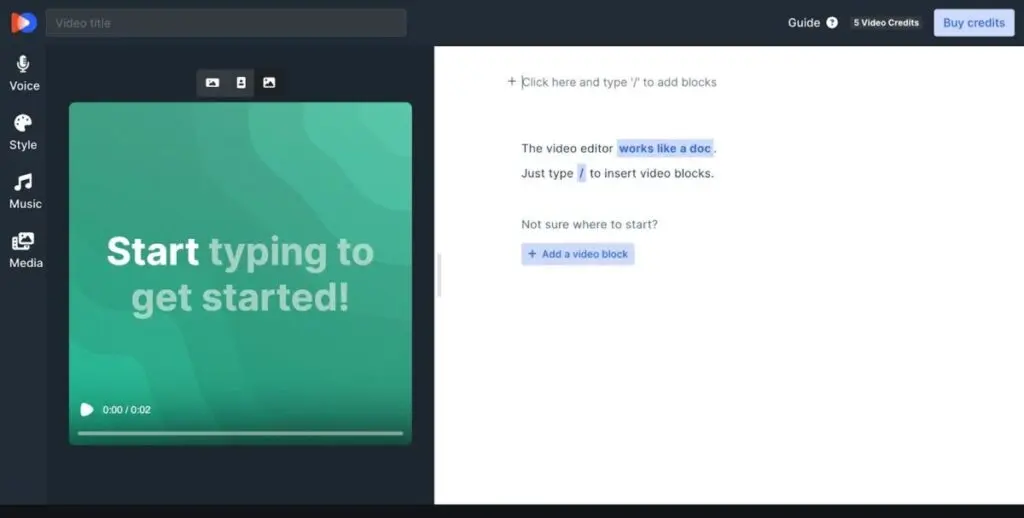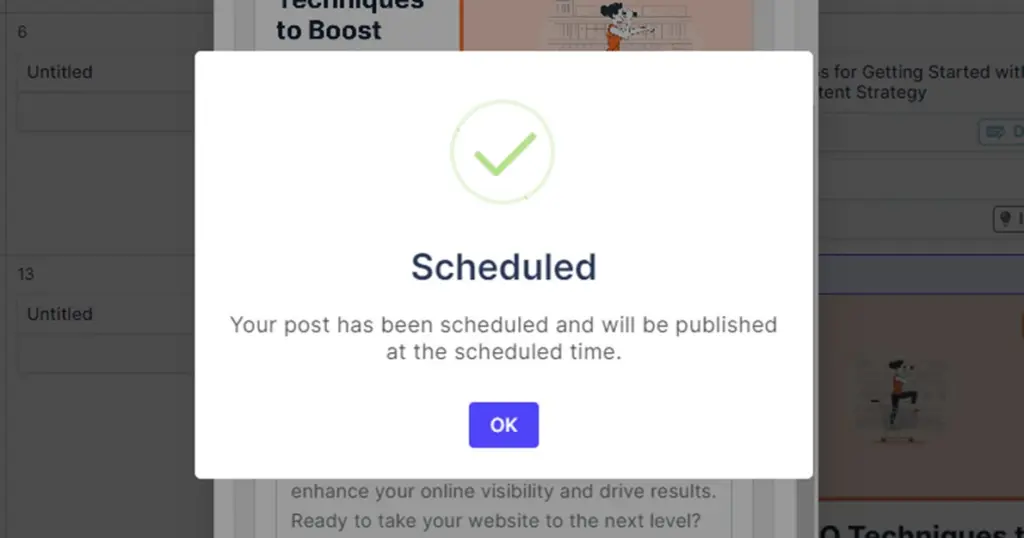Video is everywhere. It’s the driving force behind search rankings, social media engagement, and brand awareness. But let’s be real—creating high-quality videos consistently is a major challenge. It takes time, effort, and resources that many businesses simply don’t have.
That’s where AI changes the game. With 35.1% of marketers already using AI for content production, automation isn’t just a trend—it’s a powerful tool that makes video marketing faster, more efficient, and scalable. AI-poweredvideo toolscan turn blog posts, scripts, and even simple prompts into polished, professional videos in minutes. From auto-generating voiceovers to intelligent editing and seamless social media publishing, AI lets you produce more content with less hassle.
In this guide, we’ll break down exactly how AI video automation works, the best ways to use it, and how it can help you scale your marketing. Whether you’re a solo creator, a brand strategist, or a content marketer, AI video automation is the key to staying ahead in a world where video isn’t optional—it’s essential.
Unlock powerful insights with SEMrush – get started today!
Master the AI Powered Workflow for Video Content Creation
Creating video content manually has long been the Achilles' heel for marketers—essential but time-intensive, costly, and often limited by the sheer scalability constraints of human resources. Enter AI-powered video automation, a technological leap that allows marketers and content creators to produce high-quality, engaging video content rapidly and at scale. But how exactly does this automation work, and where does human input still play an indispensable role?
How AI Transforms Text and Prompts into Engaging Videos
AI video automation starts with natural language processing (NLP) algorithms that analyze and interpret textual input—be it blog posts, articles, scripts, or even short prompts. These algorithms identify key messages, critical sections, and essential themes, and then convert them into coherent video storyboards. For instance, advanced AI tools like Vidon.ai’s Video Marketing Automator seamlessly dissect blog content, automatically selecting impactful sentences and structuring them logically for visual storytelling.
Once the textual storyboard is prepared, sophisticated AI algorithms proceed to match each concept or phrase with relevant visuals—stock footage, animations, or custom-generated graphics. This process leverages computer vision and deep learning techniques that understand context, semantic meanings, and emotional nuances within the text.
The Evolution of AI Video Automation: Beyond Simple Templates
Initially, AI-powered video automation was limited to rudimentary template-based systems, generating cookie-cutter content lacking originality or audience engagement. But recent breakthroughs in machine learning have significantly evolved these tools. Today’s AI video generators employ complex neural networks capable of creating dynamic and personalized content that closely resembles videos produced by human editors.
State-of-the-art AI tools now go beyond simplistic visual matching, employing techniques such as Generative Adversarial Networks (GANs) and transformer models to create hyper-realistic animations, custom avatars, and voiceovers indistinguishable from human counterparts. Several AI-driven platforms have even developed advanced tools that produce high-quality videos, incorporating lifelike digital avatars and realistic voiceovers to enhance authenticity and boost viewer engagement.
Current Limitations of AI Video: The Indispensable Role of Human Input
Despite impressive advancements, there remain scenarios where human creativity, intuition, and judgment are irreplaceable. AI-generated content, particularly if unedited, can sometimes come across as robotic or repetitive, negatively impacting audience retention and engagement metrics—critical factors influencing visibility across YouTube, TikTok, and SEO rankings.
Human oversight becomes crucial in multiple areas:
- Narrative and Tone: AI often struggles to capture nuanced storytelling or subtle humor. Marketers should review and refine AI scripts, adding personal touches or emotional depth.
- Brand Consistency: Customization in branding—colors, logos, intros, and outros—still necessitates human decision-making to maintain brand integrity and visual identity.
- Compliance and Copyright: Automated systems might unintentionally utilize copyrighted footage or imagery. Human checks ensure compliance, originality, and platform suitability.
The optimal AI-powered video workflow thus becomes a symbiosis: AI handles repetitive, technical tasks rapidly and efficiently, while marketers and creators inject strategic, creative input that enhances engagement and quality.
How to Automate Video Marketing (Step-by-Step Guide)
Scaling video marketing used to be an uphill battle—requiring expensive production teams, hours of editing, and a steep learning curve. But with AI-powered automation, marketers can now create high-quality videos at scale without the traditional barriers.
Various AI-driven tools have emerged to streamline the entire process, from script generation to automated publishing. One such tool is Semrush’s AI Video Marketing Automator, which simplifies video production by handling the heavy lifting—letting marketers focus on strategy and creativity.
Step 1: Convert Your Blog Post into a Video
Repurposing existing blog content into video is one of the most efficient ways to scale video marketing. Not only does it save time, but it also extends the reach of valuable written content. Studies show that viewers retain 95% of a message when watched in video format, compared to only 10% when reading text. This means that transforming blogs into videos can significantly improve audience engagement and content retention.
Turning a blog post into a video manually requires scripting, selecting visuals, and assembling everything into a compelling format—an extremely time-consuming process. AI automates this by analyzing the blog’s key points and structuring them into a logical, visually appealing sequence.

Tools like Semrush’s AI Video Marketing Automator make this even easier by automatically generating a video script from the text, selecting relevant images and animations, and creating a coherent flow that requires minimal manual editing. Instead of spending hours crafting a video from scratch, marketers can generate professional, ready-to-publish videos in minutes.
Step 2: Generate AI Voiceovers & Subtitles
A well-produced video needs a voice that guides the viewer, but recording professional voiceovers can be expensive and time-intensive. AI-generated voiceovers solve this problem by instantly creating high-quality narration that sounds natural and engaging. Additionally, with 85% of Facebook videos being watched without sound, subtitles are crucial for accessibility and engagement.
Beyond improving accessibility, AI-generated subtitles and transcripts also enhance SEO by making your video content searchable and indexable by platforms like Google and YouTube. Search engines prioritize video content that includes keyword-rich captions, meaning AI-powered automation can significantly boost visibility without extra effort.
AI-powered voice synthesis tools can generate narration in multiple languages and accents, ensuring a consistent brand voice across all videos. AI Video Marketing Automator tool enhances this further by offering ultra-realistic AI voiceovers and auto-generating SEO-friendly subtitles and even translations, making videos more accessible while also improving search rankings.

Source: Semrush.com
Since search engines index subtitles and captions, videos with transcriptions are more likely to appear in search results, driving additional traffic and engagement.
Step 3: AI-Powered Editing & Enhancements
Editing is often the most tedious and resource-heavy aspect of video production. AI eliminates the complexity by automating key editing decisions, ensuring a professional-looking final product without requiring advanced technical skills.
AI-enhanced editing tools analyze the script and match it with the most relevant visuals, transitions, and effects. This intelligent automation maintains an engaging pace throughout the video while avoiding unnecessary manual adjustments.

Instead of working with complex video timelines, Semrush’s AI Video Marketing Automator allows marketers to edit videos using a simple text-based interface—modifying the script automatically updates the corresponding visuals and animations. This significantly reduces editing time, making video creation accessible even for those with no prior editing experience.
Step 4: Auto-Publish to Social Media & Websites
Maintaining a consistent publishing schedule is crucial for audience growth and engagement. However, manually uploading and scheduling videos across multiple platforms can be time-consuming and inefficient.
AI-powered scheduling tools solve this issue by allowing marketers to automate video publishing. Social media algorithms prioritize video content, but they also reward engagement signals like watch time, shares, and comments. AI-enhanced automation ensures videos are scheduled at the best times for each platform, properly tagged with relevant metadata, and formatted for each platform’s algorithmic preferences.
Semrush’s AI Video Marketing Automator seamlessly integrates with YouTube, LinkedIn, TikTok, and other social media platforms, enabling one-click publishing and scheduled posts through a built-in content calendar.

By automating video distribution, businesses can ensure they maintain a steady content flow without additional workload, leading to higher visibility, engagement, and brand consistency.
Best Practices to Ensure AI-Generated Videos Perform Well
Creating high-performing AI-generated videos involves more than simply pressing “generate” and uploading to your platform of choice. While AI automation dramatically speeds up video production, marketers need strategic best practices to ensure these videos resonate with audiences, perform well algorithmically, and ultimately deliver tangible results.
Personalize AI Videos to Boost Authenticity and Engagement
Generic, AI-produced videos often fail to connect deeply with viewers because they lack personalization, leading to lower engagement and algorithm penalties. To overcome this, avoid relying exclusively on automation—think of AI as a partner, not a substitute. Begin with AI-generated scripts, but carefully edit them to inject a human-like voice, humor, or storytelling elements that reflect your unique brand personality.
Adding custom elements such as brand logos, tailored introductions, or personalized commentary instantly distinguishes your content from standard AI-generated videos. Additionally, selecting AI tools with high-quality, dynamic voiceovers prevents the robotic monotony that frequently plagues automated videos. If your videos feature AI avatars, ensure they possess realistic facial expressions and natural body language. This level of subtlety significantly enhances viewer relatability, boosting engagement and retention.
Structure Your Content Strategically for AI Video
Well-structured scripts are essential for AI-generated videos to feel natural, engaging, and informative. AI relies heavily on clear text input, meaning the quality of your script directly influences the video's quality. Rather than overly formal or rigid scripts, write conversationally and anticipate audience questions, objections, or interests—just as if you were directly speaking to them.
To further enhance creativity and avoid repetitive or generic formats, experiment with various video styles, such as explainer animations, interviews, storytelling narratives, or even humorous shorts. Combining AI-generated scripts with human-driven creativity ensures your videos remain fresh, unique, and engaging.
Optimize Videos for SEO from the Ground Up
While AI-generated videos are effective in scaling content, many marketers mistakenly overlook the critical importance of SEO optimization. Videos that lack keyword-rich metadata, strategic subtitles, or structured descriptions rarely achieve their full potential in search visibility.
Always include AI-generated subtitles or transcripts to improve keyword relevance and searchability since search engines primarily index text-based content. Moreover, thoughtfully optimizing metadata—such as clickable titles, detailed descriptions, and strategically selected hashtags—significantly increases video discoverability on YouTube, Google Video search, and beyond. Embedding AI videos into relevant, high-quality content pages also sends positive user-experience signals to search algorithms, further boosting your overall search rankings.
Additionally, social media platforms prioritize engagement-based ranking signals such as watch time, shares, and comments. AI-powered tools can analyze past engagement data and predict which video styles, topics, or lengths are likely to perform best, helping marketers refine their strategy without guesswork. By combining AI-powered automation with data-driven optimizations, businesses can maximize both search engine rankings and social media impact.
Maintain Consistent Publishing Schedules
Consistent publishing is vital not only for building a loyal audience but also for positively influencing algorithm visibility across platforms like LinkedIn, YouTube, and TikTok. Sporadic posting makes it difficult for your videos to gain traction or audience trust.
Leveraging automation tools, such as built-in content calendars or automated social media scheduling, ensures you maintain regular uploads without increased manual workload. A predictable posting schedule encourages viewers to anticipate your content, increasing repeat engagement and ultimately boosting organic visibility.
Automate, Scale, Dominate: The AI Video Era Is Here
AI is transforming video marketing, making high-quality content creation faster, easier, and more scalable than ever. What once required a full production team can now be done in minutes—without compromising engagement or reach.
Video remains the most powerful form of content marketing, and AI removes the barriers to producing it consistently. Whether repurposing blog posts, generating AI voiceovers, or automating publishing, these tools give you the edge to stay ahead.
Now is the time to experiment. AI video automation isn’t just the future—it’s happening now. Adopt it, optimize it, and let your content work smarter, not harder.
Frequently Asked Questions
What is AI video content automation?
AI video content automation is the use of artificial intelligence to create, edit, and distribute videos with minimal human input. These tools analyze text, images, and other media to generate high-quality video content automatically, making video production faster, scalable, and more cost-effective for businesses and content creators.
How do AI tools generate videos from text?
AI-powered video tools use natural language processing (NLP) to analyze text, extract key points, and convert them into a structured video format. They match visuals, animations, and AI-generated voiceovers to the content, creating engaging videos without manual editing. Some tools also offer templates and automated scene selection to streamline the process.
Can AI help automate my TikTok content?
Yes, AI can automate TikTok content by generating short-form videos, adding captions, and optimizing trends using AI-driven analytics. Many AI video platforms allow users to quickly create, edit, and schedule TikTok videos, helping brands and creators maintain consistency without additional effort.
How do AI-generated videos perform on social media?
AI-generated videos perform well on social media when optimized for engagement. Platforms like LinkedIn, TikTok, and Facebook prioritize video content, and AI can enhance performance by adding subtitles, optimizing length, and ensuring high-quality visuals. However, AI videos should include human elements, such as branding and personalized messaging, to maximize impact.
Is it possible to make passive income with AI video automation?
Yes, AI video automation can help generate passive income by enabling creators to produce content at scale for YouTube, affiliate marketing, online courses, and digital product promotions. Many content creators use AI to repurpose existing content into monetizable video formats, reducing workload while maintaining consistent output.
How do AI-generated videos rank on YouTube?
AI-generated videos rank on YouTube when they are optimized for SEO, engagement, and watch time. Adding AI-generated captions, keyword-rich metadata, and compelling thumbnails improves visibility. However, viewer retention and interaction remain key ranking factors, so AI videos should be designed to keep audiences engaged.
How do I optimize AI videos for better engagement?
To optimize AI videos for engagement, focus on storytelling, visual appeal, and personalization. Use AI-generated captions for accessibility, keep videos concise, and add compelling CTAs. Humanizing AI videos with custom branding and voiceovers also increases audience retention and interaction.
Can AI edit and enhance existing videos?
Yes, AI tools can edit and enhance videos by automatically adjusting lighting, cropping, adding effects, and improving audio quality. AI-driven editing platforms allow users to modify videos simply by adjusting text, making video refinement faster and more efficient.
How do I avoid copyright issues with AI-generated content?
To avoid copyright issues with AI-generated content, ensure that all images, music, and video clips used are either original, royalty-free, or properly licensed. Many AI video tools provide built-in libraries of copyright-free assets. Always check platform guidelines to ensure compliance.
What is the best workflow for AI-powered video production?
The best AI video production workflow includes:
- Content Input – Use blog posts, scripts, or prompts.
- AI Video Generation – Convert text into video with automated scene selection.
- Voiceover & Captions – Use AI-generated narration and subtitles.
- Editing & Enhancements – Adjust visuals, effects, and branding.
- Publishing & Optimization – Schedule and optimize videos for SEO and engagement.
How do platforms like TikTok and YouTube detect AI videos?
TikTok and YouTube detect AI videos by analyzing metadata, engagement patterns, and content originality. Overuse of AI-generated elements without human refinement may trigger algorithmic downgrades. Adding custom edits, human narration, and interactive elements can help AI videos appear more organic.
How do I make AI videos more human-like?
To make AI videos feel more natural, use high-quality AI voiceovers with realistic intonation, add human-like facial expressions if using avatars, and integrate custom branding. A mix of AI automation and human creativity—such as manual script adjustments—ensures a more engaging result.
Can AI create original animations and graphics?
Yes, AI can generate original animations and graphics by using machine learning to create dynamic visuals, transitions, and effects. AI tools like generative design platforms can create unique illustrations and motion graphics tailored to specific content themes.



